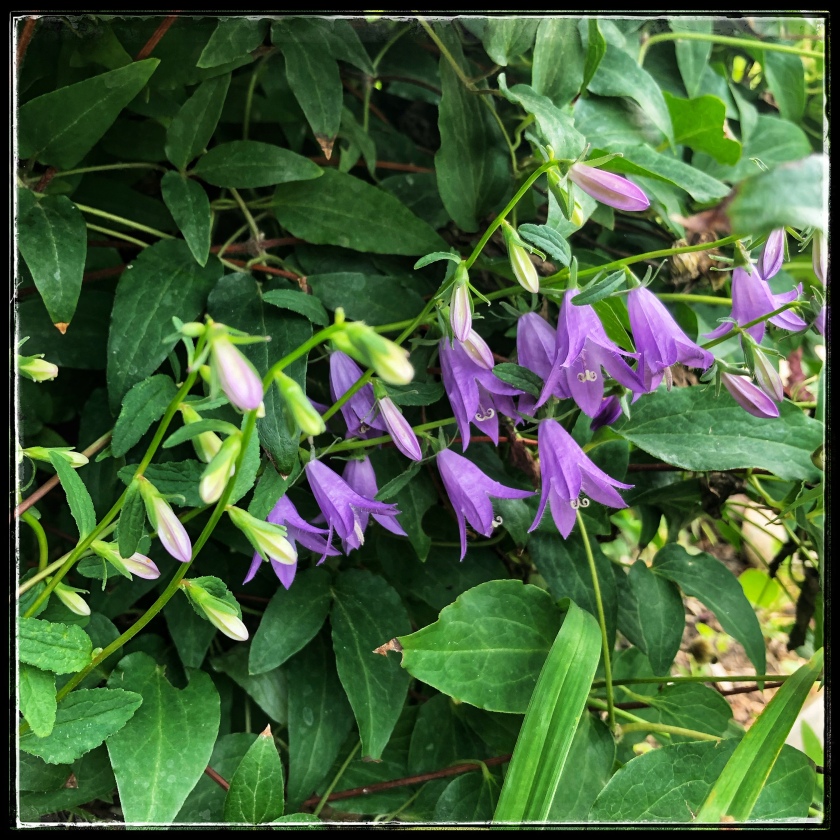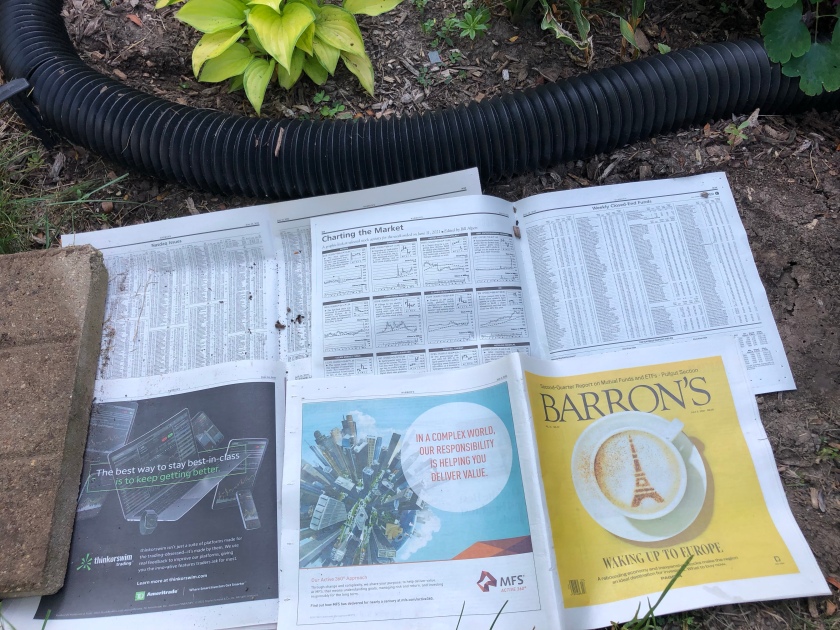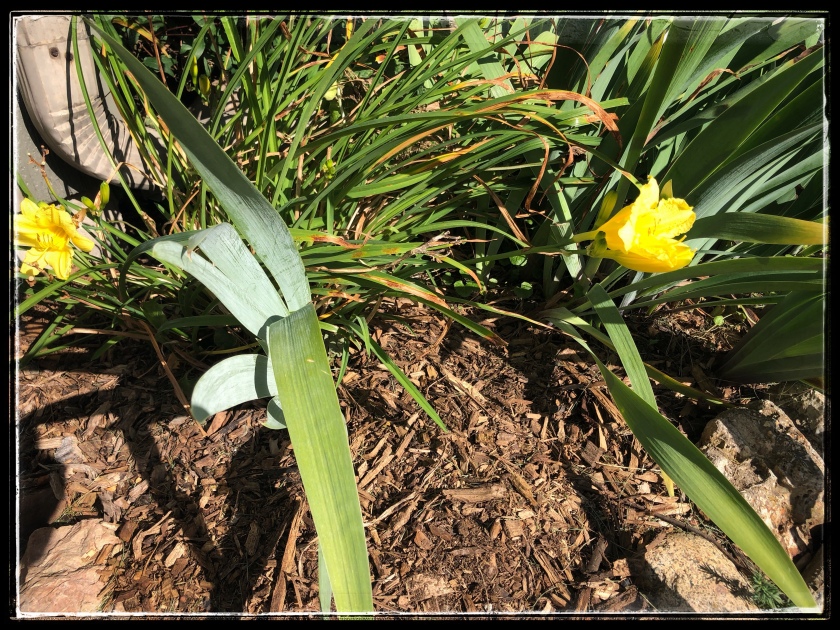It’s pretty disheartening fighting a war you will likely never win. But my battle with Campanula Rapunculoides, also known as ‘Creeping Bellflower’ has been going on in my garden for nearly two decades — ever since receiving the flower as a tagalong companion of another digging from a fellow gardener’s plentiful flowerbed. To the other gardener’s credit, she did warn me that the gifted flower might have a problematic plant tagging along. I wish I had heeded the warning and not planted the gifted plant, or just put it in a pot for a season or two, for an invasive I have come to know as creeping bellflower was indeed lurking in the soil.
This beautiful adversary is not to be confused with its better behaved look-alike, Campanula Rotundifolia, or harebells. I am personally familiar with this confusion between such similar plants, having mistakenly applied an herbicide to a little group of harebells. Sadly, as you can imagine, I had more success killing the wanted plant than I did with the unwanted invasive.
Creeping Bellflower is a bodacious beauty with a bit of folklore in its story of how it became a gardener’s curse. As I recall, it’s somehow linked to the story of how the Rapunzel of fairytales got her name. Unable to resist the allure of beautiful Campanula Rapunucloides’s lavender bells, her father stole a beautiful flower from the garden of the local enchantress and planted it in his own garden. The evil witch got her revenge by hiding Rapunzel away in a tower and cursing this flower to be a rover that takes over gardens in its path.


Fairytale curse aside, it really does look pretty intermingling with other plants.

So why get rid of it?
The problem is, this innocent looking bit of gorgeousness is so prolific, it will wage war and spread like a cancer in your garden in just a few seasons using several tactical manuevers to conquer every bit of garden space it can. The plant, also known as Rover Bellflower, is a biennial which produces a small rosette of leaves its first year, then flowers the next with the flowers producing seeds which will start the whole cycle again.
Fortifying its stronghold in the gardener’s territory, each plant sends out long, thin fingers of white lateral roots just under the surface of the soil. These slightly hairy fingers push their way through the roots of nearby plants, entangling the two plants in a messy, conflict-destined skirmish for territorial rights. This persistent perennial also sends down thick, tuberous water-seeking roots. Once nestled under the earth, a rhizome is created from which future generations of the plant will thrust their way upwards. Pulling the plant while you are weeding your flowerbeds will definitely help prevent it from going to seed (each plant produces thousands of seeds), but any portion of the root or its tiny hairs left behind will regenerate and produce a new generation of unwanted roving garden thugs camouflaged in lovely purple-ness. To complicate matters, the plant has a tuber which resides about a foot beneath the soil.
In my less than expert opinion, getting rid of weeds and unwanted vegetation without the use of chemicals should always be the gardener’s first line of defense. My personal first line of defense is to take out the enemies I can see, thus preventing the flowers from going to seed. I usually head outside to weed just after a good rain has softened the earth. If I can keep each year’s growth de-flowered, I theorize that the root system will eventually be exhausted, weaken and die. My next tactic involves a shovel and painstaking removal of the plant’s root system. As I have mentioned in a previous post, these insidious non-native plants have made my state’s list of invasive plants, so I bag them up and dispose of them according to their recommendation. My county has a special process for disposing of invasives, so I take them to an appointed drop-off place where they will be properly handled and destroyed. It is NOT a good idea to add these to your compost heap.

Pulling first-year rosettes before using the “smothering” technique
Smothering the plants when they are in the first-year rosette stage of growth can be somewhat effective in preventing the current generation of plants from making progress, but does very little to attack “the root of the problem” – that fibrous tuber lurking beneath the earth. I do occasionally use this method, especially in pathways and garden edges (see photos below), but generally take the time to dig out whatever I can and then lay down layers of newspaper or sheets of black plastic, topped with a few inches of mulch. Smothering buys me a year or two of reprieve, but the war isn’t won.

Layers of newspaper 
Mulch & pavers 
Clear 2 months later
I may make some enemies here, but I think the battle with creeping bellflower requires judicious use of an appropriate chemical over the course of several seasons. Applying an herbicide directly to the plant and allowing the plant to systemically take the chemical to its own arsenal of innermost growth paraphernalia is the most effective way to eradicate this particular foe.
I had a moderate degree of success in a few infested areas where I have used Monsanto’s glyphosate-based herbicide, Roundup. No other weed killer that I have tried has been able to kill this invasive plant. However, a great deal of care needs to be taken when applying glyphosate, as it is a non-selective herbicide, meaning it will also kill nearby plants and grass if it comes in contact with them.
Sadly, Roundup is also known to harm beneficial insects, which is a huge problem in these days of endangered bee and butterfly populations. For this reason, whenever I judiciously use Roundup (or any herbicide), I carefully remove the tempting flowers from any plant I am treating. I choose a day when the air is rather still and when rain is not predicted for a few days. Armed with gloves to protect my skin, and a sheet of cardboard, I set to work on a group of plants. Using the cardboard to shield any nearby plants, I target and spray the leaves of the plants I am trying to eradicate. Within a few hours the leaves begin to carry the herbicide to the underground parts of the weed, the leaves begin to brown and then shrivel and die.
Another great concern related to the use of glyphosate is that it has been classified as a carcinogenic in the United States since 2015, so care must be taken to avoid or minimize personal exposure to it. In fact, this herbicide may no longer be available for purchase in the near future. Bayer (Monsanto’s parent company) has announced that it will be removing Roundup from retail store shelves by 2023 due to costly lawsuits related to cancer cases.
A Canadian blog-reader of mine, Lyle Tremblay, has given me another weapon to try. Lyle once read a post I had written about my war with this plant and contacted me personally to tell me that he was working on a chemical answer to this problem which is prolific in his country as well. Lyle sent me a sample of his experimental treatment and asked me to trial his product in my garden. It was just a small sampling, so I chose a little corner of my garden that was deeply infested with bellflower. I applied the herbicide, as per his instructions. It’s two chemicals, each applied separately.

Protecting nearby plants 
Lyle’s 2-step process
It’s a somewhat tedious process, due to the need to paint two different chemicals on the leaves, but it worked. The area I treated in early summer has remained free of the weed, while the surrounding area is still infested.

If you are in a similar war with this foe and would like to learn more about Lyle’s experiment, you may contact him directly via email: maracon1@shaw.ca
